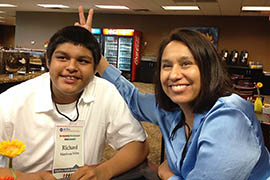Cronkite News has moved to a new home at cronkitenews.azpbs.org. Use this site to search archives from 2011 to May 2015. You can search the new site for current stories.
Phoenix out to reduce economic, human cost of disconnected youth
PHOENIX – Isaiah Whiteside first went to jail at 16. That point in his life didn’t have any meaning, he said, which led to boredom and then trouble.
“What led to my incarceration was bad association – that is always something that can get you in trouble,” Whiteside said. “I would get up, look for something to do, be bored, go out and just hang out with people who were doing the same, and we got in a lot of trouble that way.”
As a young person not in school and without a job, Whiteside fit the definition of a disconnected youth.
So did Richard Martinez-Teller, a 15-year-old who already knows what it means to be hungry and begging for money on a street corner.
“I used to just be in the street doing drugs, selling and partying,” he said. “I’d try to find shelter and food for myself so that I wouldn’t starve to death.”
As of 2012, the Phoenix area had an estimated 183,000 disconnected youth, and the Valley’s percentage of disconnected youth – 22 percent – ranked it worst among the nation’s 25 most populous metropolitan areas, according to Measure of America, a social science research group.
Whiteside and Martinez-Teller, who both speak of their lives in terms of before and after, recently addressed the second Maricopa County Education Service Agency Disconnected Youth Summit, which drew leaders including Phoenix Mayor Greg Stanton.
Stanton said the Valley’s large number of disconnecting youth translate to huge economic and societal losses for all citizens.
“There are billions of dollars of missed economic opportunity,” he said. “We have to take active steps to reach out to them.”
Stanton cited a study by the Arizona Mayors Education Roundtable showing that the social loss for a disconnected youth is $695,090.
Kristen Lewis, co-director for Measure of America in New York, has been tracking disconnected youth throughout the country. When the first report came out in 2012, she said, the biggest surprise was how few people knew about this part of their community and the biggest challenge was making the public aware of it.
“For society as a whole, having disconnected youth is bad,” Lewis said. “It’s expensive, it leads to crime rates, it’s not good for anybody – most particularly for the kids themselves – but for all of society.”
Lewis had high praise for what Phoenix has done to address the problem.
“Phoenix is different because it really responded to the report in 2012. So now Phoenix is fourth from the bottom,” she said.
Phoenix held its first disconnected youth summit held in May. The second, held Oct. 15, focused on the best ways to re-engage disconnected youth. A final summit in February will identify any gaps in the system and propose solutions.
“What Phoenix seems to be doing different is really trying to pull together a lot of different organizations to respond to this issue,” Lewis said. “They have the mayor’s office, law enforcement and a wide range of people beyond the education sector. It really takes this coordinated action to address the problem.”
Kristene Morris, chief deputy superintendent of the Maricopa County Education Service Agency, said that disconnected youth are a symptom of a disconnected system. Her office is working to make sure kids don’t fall through the cracks but to provide an easy way to get back if they do.
“We have made it very easy to get out of school but very hard to get back in and if we start to connect our social services we think we can make it easier to re-engage,” she said.
Superintendent Don Covey said the Maricopa County Education Service Agency did a lot of research on communities like Philadelphia and Boston that have track records for re-engagement.
“Our goal is that if we can cut the disconnected youth in the next five years working on a collective impact model from say 180,000 to 90,000 we will make the impact 50 percent greater for that population and reduce social cost,” Covey said.
Whiteside no longer considers himself one of Arizona’s disconnected youth. Preparing to start community college in December and hoping to become a journalist, he said that change in direction came after a lot of support and some personal reflection.
“Somebody can only tell you so much, but you have to realize it yourself and think about what it is that you want to do and you know you gotta make that step to tell yourself that you don’t want to be in trouble for the rest of your life,” he said.
Martinez-Teller still relies heavily on the support of Maricopa County Education Service Agency programs and said he is working to stay sober and finish high school. But he’s pleased with his progress.
“Right now I am busy. I have purpose,” he said. “I want to tell people how I feel about myself and not to do drugs. I just feel happy, I smile most all of the time and wake up smiling.”








